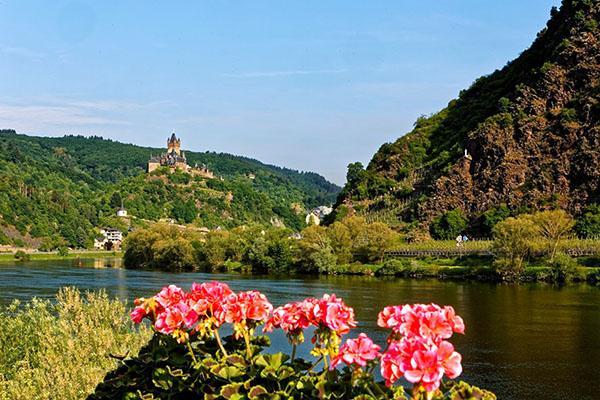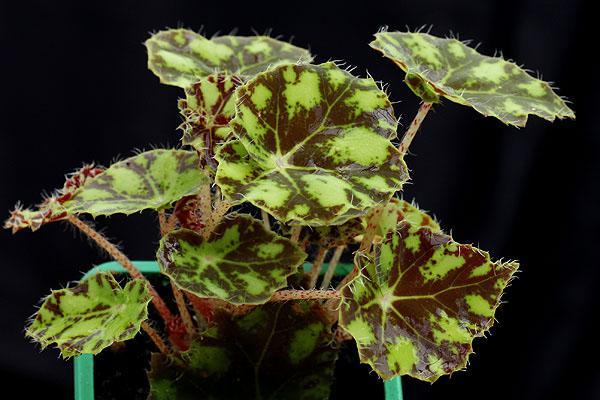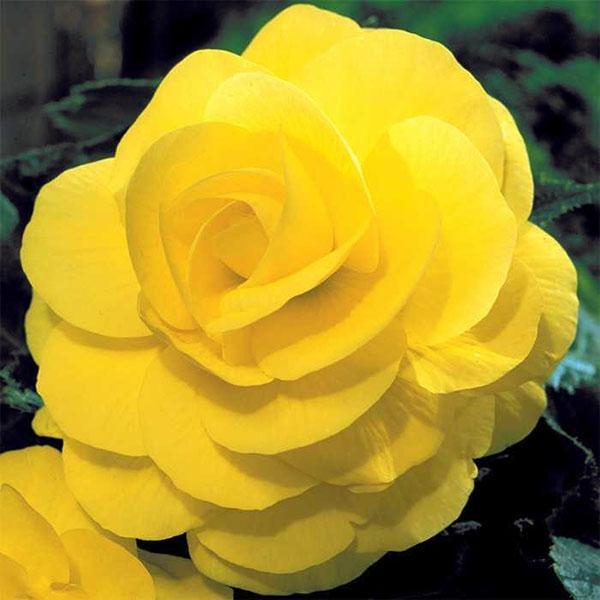Find your begonias among hundreds of varieties and species by photo and description
 Once an enterprising lover of exotic plants, the Governor of Haiti Michel Begon organized an expedition to the West Indies. Exploring the local flora, scientists discovered an unusually beautiful flower and named it - begonia... This is how the name of Monsieur Begon, who sponsored this trip in 1687, was immortalized.
Once an enterprising lover of exotic plants, the Governor of Haiti Michel Begon organized an expedition to the West Indies. Exploring the local flora, scientists discovered an unusually beautiful flower and named it - begonia... This is how the name of Monsieur Begon, who sponsored this trip in 1687, was immortalized.
The plant is the most numerous genus with over 1000 species of flowers. It can grow high in the mountains, in tropical rainforests, as well as in subtropical latitudes. A huge number of species and varieties of begonias grow in South America, where it was discovered. It is also found in the Himalayas and Africa. Some botanists believe that the birthplace of the unique flower is the African continent. It was from there that begonia spread over the earth.
General information about the exotic beauty
Begonia grows on the ground in many ways. Gardeners note the following:
- creeping herbs;
- in the form of small bushes;
- high upright options.
The root system of the plant is well developed, which allows begonias to grow not only in residential premises, but also outdoors. The root is tuberous, branched or fibrous.

 Begonia flowers are small bouquets of inflorescences of different sizes. They are:
Begonia flowers are small bouquets of inflorescences of different sizes. They are:
- red;
- pinkish;
- yellow;
- orange;
- snow-white;
- different shades of edging petals.
In each inflorescence, begonia has flowers of different sexes. Thanks to this, it is pollinated. After that, an unusual triangular box with tiny seeds grows. The plant blooms throughout the summer until late autumn. Home varieties are pleasing to the eye until the beginning of winter.
Adorable types of begonias
A huge number of varieties of exotic "foreign" is amazing. In their natural environment, botanists have counted 1,600 different species. But only a little more than a hundred of them are used for decorative decoration of an interior or landscape.
Begonia came to Russia during the reign of Peter I. Several species are mentioned in the catalog of tropical flowers that were brought from Holland in 1717. Nowadays, unique collections of an exotic plant are growing in the botanical gardens of Moscow, St. Petersburg and Novosibirsk.
Russian botanist V.V. Vorontsov conditionally identified the following categories of begonias:
- Decorative deciduous.
- Club.
- Shrubs.
- Beautifully flowering.
The classification was carried out according to the external characteristics of the plant and the field of application in horticulture.
Ornamental leafy begonia
 Plants of this type do not have a main stem, and bizarre pubescent leaves grow from the rhizome. They come in different shapes and shades. The most common leaves are green, silvery, white, brown and red. In addition, they are originally painted with multicolored patterns, spots and outer edges.
Plants of this type do not have a main stem, and bizarre pubescent leaves grow from the rhizome. They come in different shapes and shades. The most common leaves are green, silvery, white, brown and red. In addition, they are originally painted with multicolored patterns, spots and outer edges.
These plants mainly grow indoors.In view of this, caring for begonia at home requires a competent approach. Key points to pay attention to:
- correctly selected lighting;
- air humidity control;
- regular moderate watering;
- seasonal soil fertilization;
- periodic plant transplant.
Given these points, the gardener will always rejoice in the blooming decorative begonia.
With a lack of diffused lighting, the leaves lose their decorative effect, so it is important to choose the right place for planting a flower.
Tuberous begonias
 Plants of tuberous varieties are distinguished by a specific rhizome, from which translucent fleshy stems emerge. They grow up to 50 cm in height. Flowers are ordinary or double, resembling peonies or roses, small or large. In inflorescences and in a single version. It is during the flowering period that it is important to know how to care for begonia so that it delights the eye for as long as possible.
Plants of tuberous varieties are distinguished by a specific rhizome, from which translucent fleshy stems emerge. They grow up to 50 cm in height. Flowers are ordinary or double, resembling peonies or roses, small or large. In inflorescences and in a single version. It is during the flowering period that it is important to know how to care for begonia so that it delights the eye for as long as possible.
Tuberous begonia there are three types: herbaceous, shrub and ampelous, grown in hanging pots. Its heart-shaped leaves are:
- fluffy matte;
- glossy;
- corrugated;
- flat.
And their color has absorbed all shades of green. Such begonia begins to bloom in May, and ends in October. A truly charming gift from the Creator.
Shrub begonias
 All types of shrub begonias have a bamboo-like geniculate stem. Sprawling branches grow densely on it. Such plants propagate by sowing seeds or cuttings. It is best to use young shoots of the tops of an ornamental bush.
All types of shrub begonias have a bamboo-like geniculate stem. Sprawling branches grow densely on it. Such plants propagate by sowing seeds or cuttings. It is best to use young shoots of the tops of an ornamental bush.
Shrub begonias can be grown at a temperature of 15 degrees throughout the year. If the air warms up to 10 degrees, the plant dies. These species love bright diffused light, fresh air flow and moisture. Therefore, competent begonia care is the key to a chic living interior.
In order for the plant to receive a sufficient amount of water, the pot is placed on a layer of gravel with a constant supply of liquid.
When lethargic or dried leaves appear on begonia bushes, they should be removed immediately. Thus, healthy leaves will not suffer, and the plant will delight with its beauty for a long time.
Flowering begonias
 The flowering varieties are the absolute favorites of all begonias. They have surpassed their tuberous and deciduous relatives.
The flowering varieties are the absolute favorites of all begonias. They have surpassed their tuberous and deciduous relatives.
Flowering varieties grow in the form of lush bushes, decorated with clusters of cute inflorescences. Their height reaches half a meter. The leaves of the plant are asymmetric heart-shaped. They have a serrated border around the edges. Color - various shades of green. New varieties of blooming begonias delight lovers of living decorations with purple leaves.
Description of popular varieties of begonias
The unique overseas beauty has won the hearts of thousands of gardeners. Therefore, it is grown both in personal plots and in residential buildings. Acquaintance with the famous varieties of charming begonias will help you find the cherished flower.
Coralline or coral begonia
 Flowers of such begonias come in two shades: pink or orange-red. The leaf plate is silvery with olive-colored veins. The back side is in red. Looking at the begonia flowers in the photo, you can see a gorgeous brush made of miniature bright pink flowers. Most often, they bloom in the winter.
Flowers of such begonias come in two shades: pink or orange-red. The leaf plate is silvery with olive-colored veins. The back side is in red. Looking at the begonia flowers in the photo, you can see a gorgeous brush made of miniature bright pink flowers. Most often, they bloom in the winter.
Coralline grows up to almost a meter in height. Therefore, it fits harmoniously into the garden interior in hanging pots. Caring for and growing begonias at home requires a serious attitude. Thanks to this, the plant will delight its fans for 5 years.
Royal View - Griffin
 Begonia with such an exotic name can be almost half a meter in height. It differs from its relatives by its huge decorative leaves.It is grown to decorate and accentuate contrast in winter gardens. In the summer, the Griffin begonia is planted outdoors, surrounded by other herbaceous plants.
Begonia with such an exotic name can be almost half a meter in height. It differs from its relatives by its huge decorative leaves.It is grown to decorate and accentuate contrast in winter gardens. In the summer, the Griffin begonia is planted outdoors, surrounded by other herbaceous plants.
This type of begonia is quite hardy to weather conditions. He does not need special soil, and he is not whimsical to watering. Begonia grows superbly in containers in a residential area, as well as in a shaded area of the garden.
Decorative version of begonia - Rex
 This hybrid was bred from the royal begonias. It usually does not grow up to 25 cm in height. This is a fairly small plant. It is characterized by inconspicuous pink inflorescences.
This hybrid was bred from the royal begonias. It usually does not grow up to 25 cm in height. This is a fairly small plant. It is characterized by inconspicuous pink inflorescences.
The leaf plate is wide, oval in shape. The edges are serrated. There are such colors:
- gray or silver;
- purple or burgundy;
- red or bloody;
- pale pink.
The variety can be bred by dividing the bush into parts or using cuttings. Loves shaded areas of the garden with medium humidity.
Red-leaved begonia
 The plant got its name due to the fact that the back of its leaves is painted red. Their shape resembles an uneven circle. And pale pink inflorescences are an incredible decoration of the bush.
The plant got its name due to the fact that the back of its leaves is painted red. Their shape resembles an uneven circle. And pale pink inflorescences are an incredible decoration of the bush.
Usually the plant is not large in size. Its fleshy stem is gracefully pressed to the ground, which resembles a polite bow of a servant to a kind master.
This type looks original on hanging vases. If the red-leaved begonia is not flowering, home care will allow you to create thick, beautiful bushes.
Begonia loves moderate temperatures and shaded areas. Therefore, these factors should be taken into account when choosing a landing site.
Cuff or collar begonia
 This variety has a creeping stem with light green leaves. At the edges they are slightly lowered, and on the back they are decorated with red outgrowths. At the top of the sheet, they form a miniature rosette that looks like a collar or cuff. Hence the unusual name.
This variety has a creeping stem with light green leaves. At the edges they are slightly lowered, and on the back they are decorated with red outgrowths. At the top of the sheet, they form a miniature rosette that looks like a collar or cuff. Hence the unusual name.
Adult cuff begonias can bloom up to 5 times per season. This makes it possible to create a chic design in the room. The plant propagates by cuttings and by dividing the bush.
Metallic begonia
 On each leaf of the metal begonia, pollination of a metallic color is visible. Thanks to this, the plant got its name. It feels great at any temperature. Grows up to 90 cm in height.
On each leaf of the metal begonia, pollination of a metallic color is visible. Thanks to this, the plant got its name. It feels great at any temperature. Grows up to 90 cm in height.
Metallic begonia needs moderate watering. In this case, the room should be low humidity. The soil is acidic. Propagated by leaves that are previously kept in water or sand. Indoor begonias should not be sprayed; just pour water into a plate under the pot.
In order for the plant to have a beautiful shape and grow evenly, it is recommended to regularly rotate it around its axis. Real masterpieces are created with such simple movements.
Original living decoration - tiger begonia
 The plant got its name due to the stylish color of the leaves. She is sometimes called Bauer. The olive brown plate is decorated with small green specks at the edges. Each sheet is heart-shaped with pointed ends. The length is about 7 centimeters.
The plant got its name due to the stylish color of the leaves. She is sometimes called Bauer. The olive brown plate is decorated with small green specks at the edges. Each sheet is heart-shaped with pointed ends. The length is about 7 centimeters.
Looking at a plant, one involuntarily recalls a stately animal with a similar color. Begonia of this type is capable of rapid growth, due to which an original decorative version is formed. It reproduces by transplanting cuttings.
In spring and summer, the plant should be watered moderately. Bauer develops especially comfortably in diffused lighting. The temperature should not drop below 16 degrees.
When watering tiger begonia, it is important to avoid getting water on the leaves. Otherwise, they will lose their decorative appearance.
Irresistible Cleopatra
 A plant with burgundy cuttings, on which are located dark green leaves, attracts the attention of flower lovers. Begonia Cleopatra is short, about 35 centimeters.
A plant with burgundy cuttings, on which are located dark green leaves, attracts the attention of flower lovers. Begonia Cleopatra is short, about 35 centimeters.
She does not like extremes - dry air and excessive watering, as well as spraying. Propagated by cuttings of stems or leaves.
Ornamental-deciduous variety of Lucerne
 Lovers of rich greenery prefer Lucerne begonias. It has large oval castings, up to 20 cm in size. At the edges they are originally cut, which gives the plant a certain charm. The dark green leaf plate is decorated with silvery dots. The back side is reddish.
Lovers of rich greenery prefer Lucerne begonias. It has large oval castings, up to 20 cm in size. At the edges they are originally cut, which gives the plant a certain charm. The dark green leaf plate is decorated with silvery dots. The back side is reddish.
When begonia blooms, pink, brush-like inflorescences appear. It is impossible to remain indifferent looking at her magical beauty.
Video about varieties of decorative deciduous begonia
Having considered only a few varieties of the overseas beauty, one can come to the conclusion that its main advantage is the leaves. They come in incredibly bright colors, original shapes and sizes. There are no similar plants in nature. In addition, each begonia variety is adorned with luxurious flowers. The unpretentious nature of this plant attracts the attention of gardeners. The main thing is to find your begonias among thousands of varieties.